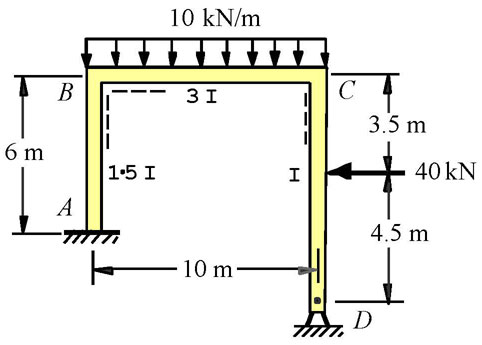A New Era for the PE Exams: Are You Ready for the New Specifications?
Part 5 – Structural Engineering Exams
By Ahmet Zeytinci, P.E., F-NSPE

As discussed in our previous articles, the new PE exam specifications were implemented, effective April 2015. In the March, April, June, and September issues, we discussed in detail the new specifications for the “Construction Module,” “Geotechnical Module,” “Water Resources & Environmental Module,” and “Transportation Module.” This month we will discuss the Structural Engineering (SE) exams.
PE SE Exam Specifications and Design Standards:
- According to the National Council of Examiners for Engineering and Surveying (NCEES), the SE exam tests the engineers’ ability to practice SE.
- The SE exam is designed for engineers who practice in jurisdictions that may license structural engineers separately from other professional engineers.
- This 16-hour (two-day) exam tests engineers’ ability to safely design buildings or bridges using a separate vertical and lateral component, particularly in areas of high seismicity and high wind.
- Exam specifications and design standards are posted 6 months before the exam administration. Updates to April exams are posted in November, and updates to October exams are posted in May.
- The exam uses the US Customary System (USCS) of units.
SE Exam Includes:
A two-day exam (Friday and Saturday) with separate, 8-hour components, as follows:
- Each day has a morning breadth and afternoon depth section.
- Friday covers Vertical Forces with Design Standards.
- Saturday covers Lateral Forces with Design Standards.
Note: the 8-hour Vertical Forces (Gravity and Other) and Incidental Lateral component is offered only on Friday and focuses on gravity loads and lateral earth pressures.
Lateral Forces (Wind/Earthquake) Component of the Structural Engineering DEPTH Exam Specifications:
The 4-hour Lateral Forces (Wind/Earthquake) depth examination is offered on Saturday afternoon. The SE exam depth modules focuses on a single area of practice. Examinees must choose either the Buildings or the Bridges module and must work the same module on both components. In other words, if you choose Bridges for the Vertical Forces component, then you must choose Bridges in the Lateral Forces component. All questions are constructed response (essay).
Buildings: The depth exam in the Buildings module covers lateral forces, lateral force distribution, analysis methods, general structural considerations (element design), structural systems integration (connections), and foundations and retaining structures.
This 4-hour module contains one problem from each of the following areas:
- Steel structure
- Concrete structure
- Wood and/or masonry structure
- General analysis (e.g., existing structures, secondary structures, non-building structures, and/or computer verification)
All problems are equally weighted.
At least two problems include seismic content at Seismic Design Category D and above.
At least one problem includes wind content of at least 110 mph.
Problems may include a multistory building.
Problems may include a foundation.
Bridges: The depth exam in Bridges covers gravity loads, superstructures, substructures, and lateral forces and may test pedestrian bridge and/or vehicular bridge knowledge. This 4-hour module contains three problems, one from each of the following areas:
- Columns (25% of your score)
- Footings (25% of your score)
- General analysis (i.e., seismic and/or wind) (50% of your score)
SE Design Standards*
These standards apply to the Vertical and Lateral components of the SE exam. Effective beginning with the April 2015 examinations, Revised April 20, 2015.
Abbreviation & Design Standard Title:
AASHTO, AASHTO LRFD Bridge Design Specifications, 6th edition, 2012, American Association of State Highway & Transportation Officials, Washington, DC.
IBC, International Building Code, 2012 edition (without supplements), International Code Council, Falls Church, VA.
ASCE 7, Minimum Design Loads for Buildings and Other Structures, 3rd printing, 2010, American Society of Civil Engineers, Reston, VA.
ACI 318, Building Code Requirements for Structural Concrete, 2011, American Concrete Institute, Farmington Hills, MI.
AISC, Steel Construction Manual, 14th edition, American Institute of Steel Construction, Inc., Chicago, IL.
AISC, Seismic Design Manual, 2nd edition, American Institute of Steel Construction, Inc., Chicago, IL.
AISI, North American Specification for the Design of Cold-Formed Steel Structural Members, 2007 edition with Supplement No. 2 (2010), American Iron and Steel Institute, Washington, DC.
NDS, National Design Specification for Wood Construction ASD/LRFD, 2012 edition & National Design Specification Supplement, Design Values for Wood Construction, 2012 edition, American Forest & Paper Association, Washington, DC.
NDS, Special Design Provisions for Wind and Seismic with Commentary, 2008 edition, American Forest & Paper Association, Washington, DC.
PCI, PCI Design Handbook: Precast and Prestressed Concrete, 7th edition, 2010, Precast/Prestressed Concrete Institute, Chicago, IL.
TMS 402/602, Building Code Requirements and Specifications for Masonry Structures (and related commentaries), 2011; The Masonry Society, Boulder, CO; American Concrete Institute, Detroit, MI; and Structural Engineering Institute of the American Society of Civil Engineers, Reston, VA.
Final Notes: Solutions to exam questions that reference a standard of practice are scored based on this list. Solutions based on other editions or standards will not receive credit.
Check our previous articles (September 2015) for the open-book policies.
Good Luck,
Ahmet Zeytinci, P.E., (Dr. Z.)
This email address is being protected from spambots. You need JavaScript enabled to view it.
The NCS congratulates Dr. Z on his award and article in PE magazine. View the article now!


